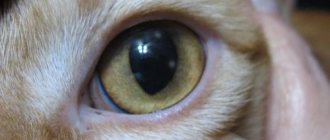Alena Igorevna Goncharenko
veterinarian Petstory
Rabies is an extremely dangerous incurable neurotropic viral disease that occurs in most warm-blooded animals, including cats, and is characterized by severe damage to the central nervous system. The rabies virus (Rabies lyssavirus) is equally dangerous to all people, cats, other susceptible animals and birds and can be transmitted between them. Cats are one of the most susceptible animal species to this disease.
Rabies in cats: the main thing
- All cats are susceptible to the disease, regardless of gender, age and breed;
- Transmission of the virus occurs primarily through the saliva of an infected animal;
- From the moment the virus enters the body until the development of the disease, an average of 2 to 3 months can pass, in rare cases from 1 week to 1 year;
- From the moment a cat becomes infectious to humans, the animal's death occurs within 10 days; there is no treatment;
- Timely vaccination helps to avoid the disease with a probability of up to 100%.
Causes of the disease
The main route of transmission of the virus from a sick cat to a healthy one is through saliva, since the maximum concentration of this virus is found in it. Saliva mainly enters wounds and the bloodstream through bites, but can also enter the body through mucous membranes and even, according to some sources, through intact skin when licking each other. Cases have been described in which domestic cats that lived in a private house outside the city, but did not have contact with other cats and dogs, were found to have the rabies virus. It was determined that the infection occurred after forest urchins ate from their bowls and left their saliva there. It is also not uncommon to find signs of rabies in cats that catch and eat infected rodents.
In the United States, cases of airborne infection have been reported after visiting caves that are densely populated by bats, but not everyone who visited the cave became ill. Also, in laboratory conditions, it was possible to achieve infection through the oral route by ingesting contaminated food and water. But so far, both of these transmission routes remain controversial.
Vaccination
How much does a cat's rabies vaccination cost? In state veterinary hospitals, injections of anti-rabies medications are provided free of charge. Specialists use domestically produced products that are well tolerated by pets. However, this service is also offered by those doctors who work in private institutions. They use imported drugs. The procedure is carried out for a fee. How much does a cat's rabies vaccination cost? The price varies from 300 to 1000 rubles. The vaccine provides stable immunity for 3 years.
Symptoms and signs of rabies in cats
Symptoms of the development of rabies in cats can be divided into 4 stages. It is not always possible to clearly trace the boundaries between these stages, since the disease can progress very rapidly. However, the symptoms of rabies in small kittens are similar to those in adult animals.
Let's look at how each stage of rabies manifests itself in cats:
- Incubation period
There will be no obvious clinical symptoms at this stage, but the virus has already begun its movement and reproduction along the nerve fibers towards the brain. The first signs of rabies in cats include a slight decrease in activity, loss of appetite, and drowsiness. The same signs are usually present in most other contagious and non-contagious diseases. The cat may become more sociable, or, conversely, silent. The voice may become duller, but it may not change at all. The incubation period lasts on average 2-3 months, sometimes from 1 week to 1 year.
- Prodromal period
Its duration is about a day. At this stage, the cat exhibits signs more characteristic of rabies. The owner can already notice changes in the pet’s behavior that cannot be associated with any events in the cat’s life, that is, no changes in the environment have occurred. If previously the cat was self-sufficient and did not need human attention, now it can become very affectionate and constantly seek contact with its owner. But if the cat has always been sociable, now, on the contrary, it may begin to hide and avoid affection. Another unusual symptom is pica - eating inedible objects. In such cats, you can find toys, stones and even cutlery in their stomachs.
- Excitation period
Most often, rabies in cats occurs in a violent form, which is not typical for many other animals. The duration of the stage is about 7 days, or in the case of a hyperacute course, the disease immediately passes to the 4th stage. The concentration of the virus in saliva at this moment is maximum, and the cat is most dangerous to other animals and people. At this stage, the cat exhibits increased irritability and extreme nervousness. Any loud sound or flash of light provokes aggression; the animal is ready to fight with all its might. In addition to getting dangerous injuries from teeth and claws, there is a huge chance of contracting a virus. In addition to aggression, various nervous phenomena can be noted: spasms of skeletal muscles, convulsions, walking without a goal. Hydrophobia may develop (hydrophobia is the second name for the rabies virus), due to a spasm of the muscles responsible for swallowing. Salivation may occur, most often of a foamy nature.
- Period of paralysis
This is the final stage of development. At this stage of rabies, the following symptoms can be observed in a cat: convulsions, uncoordinated movements, paralysis of the eye muscles, lower limbs, and zygomatic muscles. Death occurs due to paralysis of the respiratory muscles.
Hurry up, choose a box and find out what gift awaits you
Discount on pet insurance
Promo code copied to clipboard
Main types of hydrophobia
The following forms of hydrophobia exist:
- Violent (typical). It occurs most often.
- Paralytic, or silent.
- Abortive.
- Returnable.
- Atypical.
The first two types are similar to forms of the disease in humans. And the other three are observed only in representatives of the cat family.
Forms
There are three forms of rabies in animals:
- Violent form
We discussed the violent form of rabies in cats in detail in the section on symptoms and signs, since it is the most common form of rabies in cats, but there may be exceptions. The main difference between this form and the others is that the animal turns from a gentle domestic animal to wild and aggressive. This happens due to severe damage to the brain; we can say that the virus controls the animal and forces it to bite others, thus spreading through saliva.
- Silent form
With this form of flow, excitation is not expressed at all or is weakly expressed. Sometimes rabies in kittens can manifest itself in this way. Paralysis progresses quite quickly, swallowing becomes difficult, and profuse, foamy salivation is observed. The animal's gaze is expressionless, indifferent, directed as if into emptiness. There may be prolapse of the third eyelid, strabismus, and different pupil sizes. Death occurs even faster than with the violent form, on the 2-4th day.
- Atypical form
This form of flow is extremely rare. Refusal to eat, exhaustion of the animal, inflammatory processes in the gastrointestinal tract, and hemorrhagic diarrhea are noted. No aggression is observed. This form can last up to 3 months or longer.
Other rare types of pathology
Atypical rabies lasts quite a long time. This form resembles a violent one. However, the animal lacks excitability and there are disturbances in the gastrointestinal tract, for example, diarrhea.
Abortive type is a rare type of disease. At the beginning of the second phase of its development, symptoms suddenly disappear. The cat makes a full recovery. This form is still poorly studied. It is impossible to say what causes the cessation of the disease.
The recurrent type is characterized by a relapse of the pathology after an imaginary recovery. Attacks of hydrophobia alternate several times with a break of up to three weeks.
Diagnosis of rabies in cats
Unfortunately, there are no intravital tests to detect rabies in cats. To make a preliminary diagnosis, you can rely on the available medical history: the animal had access to the street, there was contact with wild or stray animals, there were episodes of hunting mice and other rodents, hedgehogs, foxes and other forest animals entered the area around the house. It is also necessary to pay attention to clinical symptoms: changes in behavior, various nervous phenomena, eating inedible objects, drooling. An animal suspected of rabies is placed in isolated quarantine for up to 10 days. During this period, progression of symptoms and death can be expected. The diagnosis can only be confirmed by examining sections of the brain using microscopy, that is, posthumously.
Rabies vaccinations
Most commercially available rabies vaccines require immunity to develop for at least 1 year after vaccine administration, with some providing protection for up to 3 years. Russia is a disadvantaged country regarding rabies, therefore, according to Russian legislation, all cat owners are required to vaccinate their pets against this disease annually. Fully domestic cats should also be vaccinated against rabies. Special services carry out vaccination of wild and stray animals, this is especially important in regions unaffected by rabies. Vaccination is carried out by the oral method, that is, in forests and habitats of stray animals, edible baits are laid out, inside of which there is a capsule with the vaccine. Vaccination is the best prevention of rabies in cats; the risk of adverse reactions from vaccination is immeasurably small compared to the damage that infection can cause.
You can get your cat vaccinated at any veterinary clinic. Clinics usually have several vaccines to choose from:
- Single-component vaccines that provide protection only against rabies;
- Complex medications that will protect your pet from several diseases at once. Basic diseases include vaccinations against panleukopenia, calicivirus, and rhinotracheitis.
Your doctor will help you decide on the choice of vaccine during your examination.
To prepare for vaccination, you need the following:
- The cat must be completely healthy and have no complaints. If you have any doubts about the condition of your pet, you must first come to the clinic for an examination;
- 10-14 days before the scheduled vaccination, it is necessary to deworm the cat. If treatments for helminths are regular all year round (at least 2-4 times a year for a domestic cat), then additional treatment before vaccination is not required.
Before vaccination, the doctor will once again make sure that the pet is in good health, examine it, and, if necessary, prescribe additional diagnostics.
Therapy
There is no cure for hydrophobia. If symptoms occur, the animal dies. If a cat scratches or bites its owner, or if the pet’s saliva gets on his skin, the person needs to thoroughly wash the affected area with warm water and laundry soap. If the diagnosis is confirmed, the owner must go to a medical facility and undergo a course of injections (7 injections over 6 months). Ignoring therapy will lead to death. Therefore, you need to start treatment as quickly as possible.
The only reliable protection for an animal against this terrible disease is a vaccine. Does a domestic cat need to be vaccinated against rabies?
Injections of an anti-rabies drug are necessary for pets who travel with their owners, walk in nature, or take part in exhibitions. However, even if the pet does not leave its home, its owners should not ignore this medical measure.











